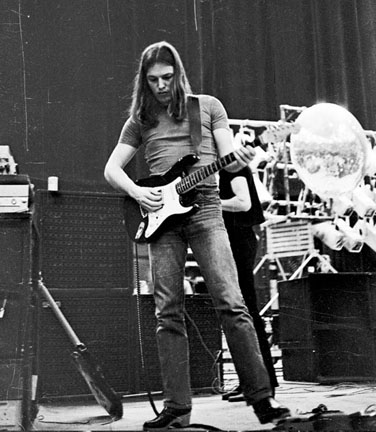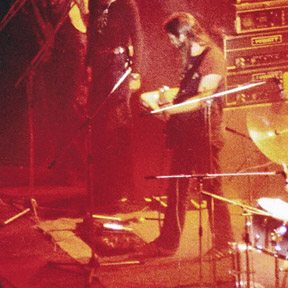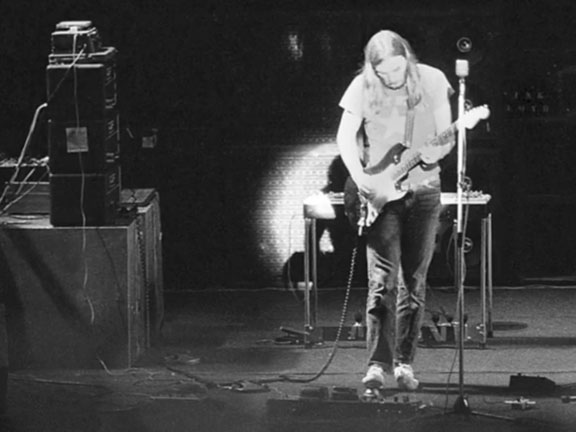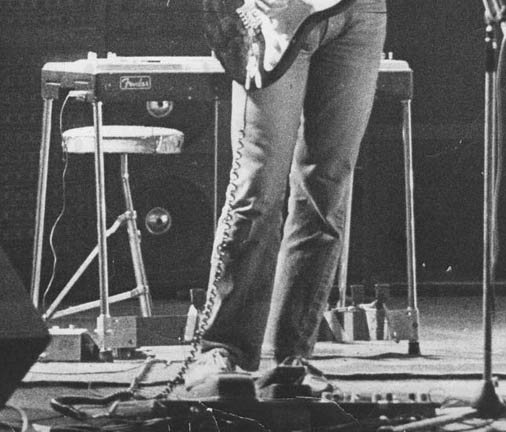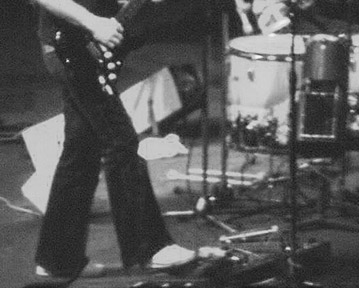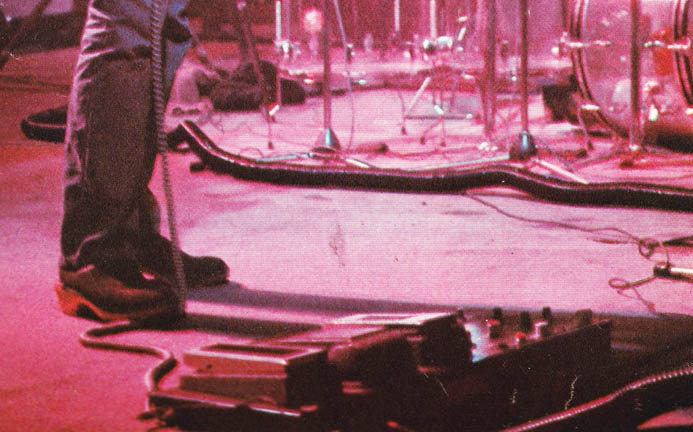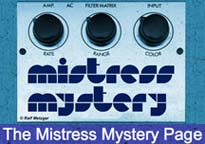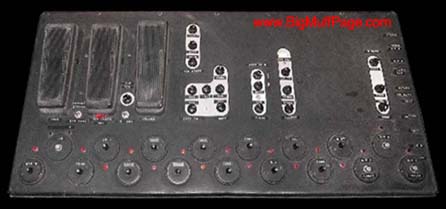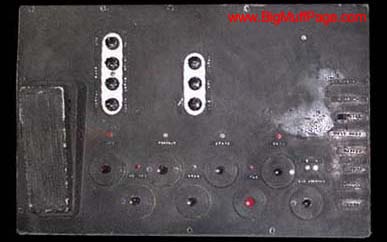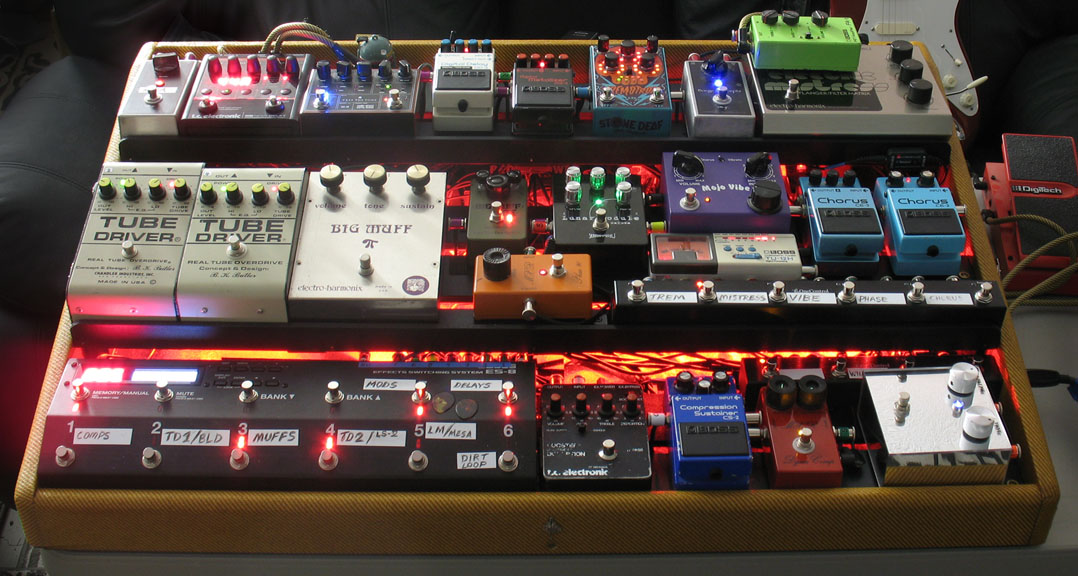NOTE: This website is frequently updated. Last update July 2020.
DAVID GILMOUR'S EARLY PEDALBOARDS - In the early 1970s when effects pedals were becoming more prominent it was not uncommon to see them on the stage floor of live gigs. Most guitarists had one or two, but David Gilmour's collection was growing every year. By 1972 he had a string of them in series on the floor. This was in the days before true bypass switching, so the guitar signal passed directly through all the pedal circuits before getting to the amplifier, loading up and weakening the signal. This degraded the original guitar tone as well as added hiss and other noise. Below is David describing the problems with that setup.
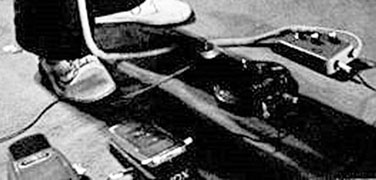
David Gilmour's effect pedals from 1972
I had a fuzz box before but it was Syd's (Barrett), and I couldn't get along with it. I changed that (to a Fuzz Face) and I gradually added a volume pedal as well, because fuzz boxes are terribly hard to control without a volume pedal…and a wah-wah. I was actually working through all that stuff until I had a huge line of them sitting on stage with wires everywhere. Batteries running out out and breaking down. I used to have a terrible time.... Lots of the pedals had the quality lost to them, and screeches and all that sort of stuff. It got to the point where I had to have it all built into one unit…- David Gilmour in 1978
Simple pedalboards already existed at the time. They were literally individual effects pedals fastened to board. Peter Banks, guitarist for Yes and Flash, claimed to have had the first pedalboard ever made, built by Michael Tate. Effects rig builder Pete Cornish said the first board he built was in 1972 for Peter Banks, but he calls that a 'practice run' and considers the board he made for Robert Fripp in September 1973 his first real pedalboard. The Cornish design was to enclose all the wiring inside a flat floor cabinet with the effects pedals bolted to the top, all powered by a single battery housed in the cabinet underneath.
I can just plug in and go with almost anything. I used to be much more fanatical about it when I was younger. I built all of my first pedalboards myself. It was my idea to have all the pedals on all the time, with each of them on a bypass switch, so that the signal didn’t go through the electronics of any pedals that weren’t being used. Then, when Pete Cornish began building boards for me, I asked him to follow that general design. - David Gilmour from the January 2009 issue of Guitar Player
For Pink Floyd's Dark Side of the Moon tour in 1973 David had a need for something much more complex, but more simplified for the user, so he came up with a different way to do it. I think he more-or-less invented the idea for the integrated effects pedalboard at this time. He had roadie and stage technition Chris Adamson build it for him and began using it in early 1973. Chris worked with Pink Floyd from Meddle to The Wall. He is actually the first voice heard on Dark Side of the Moon ("I've been mad for f*cking years"). He is also the roadie who accidentally wired David's wah wah pedal backwards, causing it to squeal, which David ended up using as an effect on several Pink Floyd songs. Here is Chris describing a switch he added for that effect to David's first pedalboard. He refers to Dark Side here, which is the tour he bult the board for, but the song he is referring to is actually Echoes from Pink Floyd's Meddle album.
There is a pedalboard that I'd built for Dave that I'd forgotten about. On Dark Side of the Moon there is a part on there when you get this sort of screeching sound for the guitar. It sounds a bit like a seagull. Well, how that came about, I wired his wah wah pedal the wrong way around, so when you switched it on, you got this high pitched sqeal scream, and Dave loved it. So we built a switch (in the pedalboard) so we could have the wah-wah pedal as it should. Put it in the other position and you got this high pitched squeal. - Chris Adamson on Radio Free Radio in 2017
(shown above) Gilmour using his first pedalboard in 1973. It was built by roadie tech Chris Adamson. The built in effects were:
Dallas Arbiter Fuzz Face
Vox wah wah (on top)
Colorsound Power Boost
Univox Uni-Vibe
DeArmond volume pedal (on top)
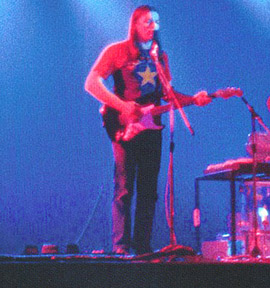
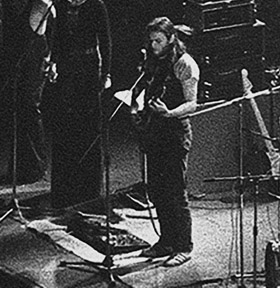
(shown above left) Gilmour using his first pedalboard for the Dark Side of the Moon tour in Ohio, March 1973
(above middle and right) Gilmour in London, May 1973. It may look like a Pete Cornish pedal board, but David was
using this type of pedalboard long before Pete ever made a pedalboard for him(shown above) Gilmour using his pedalboard with Pink Floyd in 1974


(shown above) Gilmour using his pedalboard in Atlanta 1973 (left) and in Boston 1975 (middle/right)
The design of the pedalboard was very different from what other people were doing at the time. All of the effects circuits and wiring were built inside the floor cabinet to protect them. All of the controls and switches were on the top, including a volume pedal. Each effect was in its own individual bypass loop, rather than all connected in series. Each bypass loop had a foot switch. The effects were always on and could be brought into or out of the signal chain at the the press of the bypass switch. Rather than relying on batteries for all the individual pedals, the board was mostly powered by one AC mains power source. That early pedalboard was not perfect however. This is David describing problems with it.
I used to have trouble when I didn't have the right amount of poles on the switches that you could get a hold of. You need to have an extra circuit for the lights, the LEDs that come on. Because the poles - when they used to connect it on the same pins - I used to get clicks and buzzes from the lighting circuit, so I didn't use those. The pedal board didn't have that (LED lights) and I would get completely lost because I didn't know what (effect) was on or off. They have got these switches out in the last few years now that you can have a completely separate circuit for the lights.
(shown above) David Gilmour's revised integrated effects pedalboard used from 1974-1975. The built in effects were:
Dallas Arbiter Fuzz Face
Cry Baby wah wah (on top)
Colorsound Power Boost
Univox Uni-Vibe (speed control pedal on top)
MXR Phase 90
DeArmond volume pedal (on top)I had my pedalboard built the way I did, which is the circuitry is on all the time. And what you have is an on/off switch when you go to those circuits, it's a bypass switch. The main lines are running right through from the beginning and there's lots of switches, and that's all you are actually connected to. Your signal goes in and out…and you only go through the circuitry and everything when you're actually using it (the effect). There's only one or two things in the circuit on at a time, so you don't suffer that quality loss. - David Gilmour Interview by Steve Rosen in 1978
What David is describing above are bypass loops for each effect, something that is a standard today. He only switched in the effects he needed at a given moment, so only those effects were on the signal chain. Everything else remained bypassed. He had the board revised in 1974 to add and change out a few effects, but he continued to used it until 1975. I do not think anyone other than Gilmour had that type of board at the time. Effects rig legend Pete Cornish built several pedalboards for King Crimson in 1973, but they were just a thin board with the effect pedals bolted on top, not an all-in-one integrated box like David designed.
GILMOUR'S PETE CORNISH PEDALBOARDS - Pete Cornish did not start building integrated pedalboards like David's until 1976 when Phil Talor, Pink Floyd's backline tech, contracted him build an all new pedalboard to be used by David on Pink Floyd's 1977 tour. It basically followed David's existing pedalboard design concept, incorporated all of his original ideas, but was a much improved version. This time he was able to have LEDs so he could see when an effect was on or off! The pedalboard also incorporated Pete's own ideas and practices to maximize the signal, optimize the performance of each effect, and keep the hiss and hum noise from entering the system. It was the most effects Pete had ever placed in a single pedalboard at the time. He used those same ideas and David's pedalboard design for his other clients from that point on.
I had a pedalboard made years ago (1972-73) , and I established various principles that I wanted on my pedalboard at that time. Pete Cornish added some of his ideas to some of my ideas, and made me up a board (in 1976) that was just what I needed. I know he's used some of my ideas on other people's pedalboards since then. For me, it's just a very simple thing, just the least complicated you can get. - David Gilmour from the November 1984 issue of Guitar Player
March 7th 1976 was when the very first drawings were done for the first board I built for Dave – that included a Fuzz Face, a Cornish Custom Fuzz, MXR Phaser, a Uni-Vibe, a CryBaby, MXR Dynacomp and an MXR noise gate. The routing starts with an input selector for two guitars, then onto a strobo tuner feed, then a master bypass before we get to the effects...the board had three modified CryBabys on it – one of them is a tone control and one is a volume control, only one was actually a wah. The next thing is the Fuzz Face – Dave really liked the Dallas Arbiter Fuzz Face a lot – then my fuzz, then the MXR Phase 100, the Uni-Vibe, then the wah with a reverse switch on it to reverse the travel, the MXR Dynacomp, then a send and return, the MXR noise gate and then three outputs, each with their own on/off switch, so Dave could have any combination of the three amps (HiWatt, Marshall or Yamaha) on at any one time. - Pete Cornish from the July 1995 issue of Guitarist magazine
David talked about the design of his Cornish pedalboards in a late 1978 interview by Steve Rosen, some of which was published in the May 1979 issue of Guitar Player. Steve was kind enough to post the full audio recording of the interview on Youtube. Below is a partial transcription of that interview.
I have been through a couple of completely different pedal boards since then, but basically the pedalboard I have now (Pete Cornish board from late 1978) is really a main switching unit with a series of standard off the shelf units, which include MXR phasers, an Electric Mistress flanger, an orange treble and bass booster (Colorsound Power boost), a Big Muff fuzz box and Fuzz Face fuzz box. I had one of those Uni-vibes in there for a while but it went out to make room for something else a couple of years ago. What else? There's a Volume and Tone pedal. Everything is on switches that bypass it completely, including the volume and tone pedal. And at various points in the circuitry I have outlets going external to the pedal board. Two sockets with short circuit connectors (send/return jacks) on so that you can plug in two short wires and add an external thing into the circuitry at the point you want to put it into the circuitry. And if you pull the plugs out the circuitry still works because you have got it short circuited. Also its got three switched outputs, to switch it out to different amps. - David Gilmour Interview by Steve Rosen in 1978
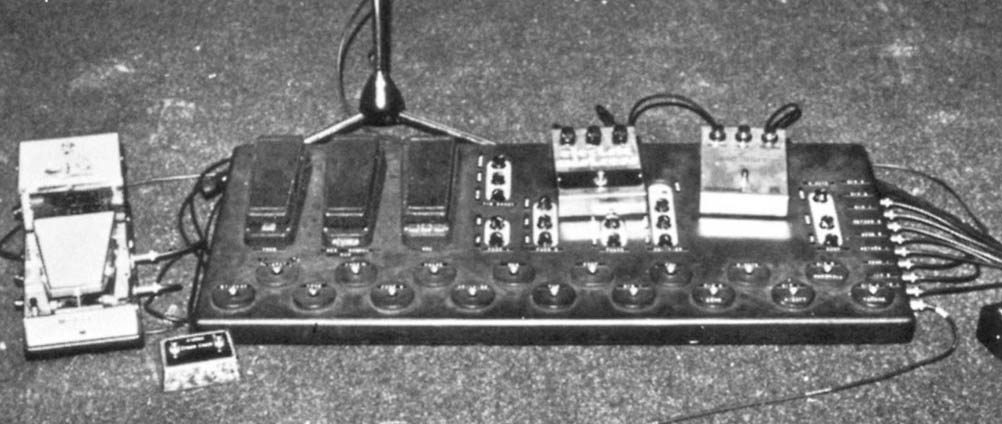


(shown above) David Gilmour's first Pete Cornish pedalboard built in 1976 with a Big Muff and Electric Mistress on top, connected with send/return jacks.
It was an improved version of the pedalboard David designed for himself that was built by Chris Adamson and used from 1973-75
(shown above) The modified Pete Cornish pedalboard used for The Wall shows in 1980-81 (left photo)
with a built in Big Muff. Cornish built a smaller front-stage board (right photo) that was used for the
second half of the show. These were just two of 11 Cornish boards used for The Wall performances
I cut the volume control out when I am not using it. I've got a switch to switch the volume pedal out, and the tone pedal I switch out. And I've got a master bypass, so that I can kind of pre set a combination of things on the board before I cut them all in, and I can cut them all in at once. I just press it and the whole lot comes in together. - David Gilmour Interview by Steve Rosen in 1978
The “master bypass” switch David described was used is a similar manner as modern Midi pre sets or programmable loop switchers are used today. It’s just that David had to manually switch each effect in the pre-set on himself, before hitting the master bypass to activate them all simultaneously. David first began using simple programmable pre sets in the 1980s, and they are now standard in the industry. As technology advanced to allow much more complex pre-programmed effects loops using MIDI switching systems, David used those in his larger Pink Floyd rigs in 1987-89, 1990, 1994, and in his solo tour rig in 2015-16. David continued to have Pete Cornish make pedalboards for him on and off throughout his career, with the last one built in 2006.
These days most guitarists use individual effects mounted to a pedal board and use standard loop switchers to bring each effect into or out of the signal chain. Some guitarists use programmable loop switchers to select a group of effects all at once using pre-programmed pre sets. I use a combination of manual loop switchers and programmable loop switchers on my own pedalboard, shown below.
Kit’s Secret Guitar, Gear, and Music Page
Guitar stuff, gear stuff, soundclips, videos, Gilmour/Pink Floyd stuff, photos and other goodies.
Copyright Kit Rae.
VISIT MY SWORDS, KNIVES and FANTASY ART WEBSITE www.kitrae.net

